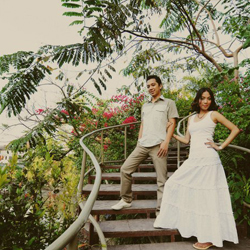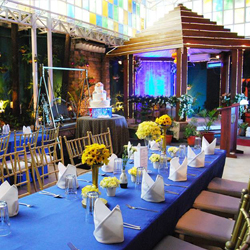Maguindanao - The Seat Of Muslim Mindanao
Maguindanao is the only predominantly Muslim province of the four that were created out of the former province of Cotabato. Today it holds the seat of the Autonomous Region for Muslim Mindanao (ARMM), specifically in Cotabato City. As the seat of ARMM, Cotabato City and the rest of Maguindanao has become the center of trade and culture of the region.
More than a regional capital, Cotabato City has its own array of wonderful sights for the nature loving visitor. As for the municipalities of Maguindanao, its treasures await discoverers who will pronounce to the world the wonderful gems of the province.
Demographics
1. Population - 1,532,868
(as of 2007 Census)
2. Land Area - 7,318.0 sq. km
3. Capital - Shariff Aguak
4. Language/Dialect - Maguindanaoan, English, and Filipino
5. Divisions
Cities (1)
- Cotabato City (independent city)
Municipalities (36)
- Ampatuan
- Barira
- Buldon
- Buluan
- Datu Abdullah Sangki
- Datu Anggal Midtimbang
- Datu Blah T. Sinsuat
- Datu Hoffer Ampatuan
- Datu Odin Sinsuat (Dinaig)
- Datu Paglas
- Datu Piang
- Datu Salibo
- Datu Saudi-Ampatuan
- Datu Unsay
- Gen. S. K. Pendatun
- Guindulungan
- Kabuntalan (Tumbao)
- Mamasapano
- Mangudadatu
- Matanog
- Northern Kabuntalan
- Pagagawan
- Pagalungan
- Paglat
- Pandag
- Parang
- Rajah Buayan
- Shariff Aguak (Maganoy)
- Shariff Saydona Mustapha
- South Upi
- Sultan Kudarat (Nuling)
- Sultan Mastura
- Sultan sa Barongis (Lambayong)
- Talayan
- Talitay
- Upi
Autonomous
Region for Muslim Mindanao (ARMM) Compound
It is a showcase of a unique blend of modern and Muslim
architecture.
Rio de Grande
de Mindanao
It is the second largest river in the Philippines and
the longest in Mindanao, crisscrossing with its tributaries
the city's vast area.
P.C. Hill
This historic hill served as a watchtower for the natives
in their defensive drive to detect and repel assaults
by enemies.
Kutawato
Caves
It is the only cave in the country that is right in
the heart of the city.
Our Lady
of Lourdes Grotto
It is a replica of France's Our Lady of Lourdes Grotto
and believed to be miraculous.
Historical
Takumi Butai
Memorial Shrine
Location: San Sebastian Compound, Cotabato City
The monument is in honor of Takumi Butai and the Japanese
soldiers who died here during the second World War.
Takumi was the Provincial Commander of the Japanese
forces assigned in Cotabato City. Before he died, he
requested that some of his ashes be buried in Cotabato
City.
Kutawato
Caves
Location: Tantawan Hill, Cotabato City
It got its name from the words “kuta” means
fort and “wato” means stone hence the name
fort of stone. Kutawato caves with its walls of white,
beige and brownish shade, glitters in the dark and echoes
a colorful past dating back to the days when no foreign
foot yet trampled upon this island. These caves had
given sanctuary to the natives when the Spaniards tried
to convert them into the faith. It also served as garrison
and armory for Filipino guerillas who fought the invading
force of the Japanese Imperial Army during the Second
World War.
Man-made
Autonomous
Region for Muslim Mindanao (ARMM) Compound
Location: Gov. Gutierrez Avenue, Cotabato City
Considered as the symbol of the Bangsamoro’s struggle
for self-determination, the ARMM conducts governance
in a 4-hectare compound housing the Office of the Regional
Governor, Regional Legislative Assembly, Shariff Kabunsuan
Cultural Center, Regional Museum and Regional Offices,
including those of Region XII of which Cotabato City
is a part of. The buildings in the compound showcase
unique blend of modern and Muslim architecture.
Cotabato
City Hall
Location: Cotabato City
It is a century-old structure that houses almost all
the city government offices. It showcases a unique antique
architectural design depicting Muslim art.
Caverna
Espanola
Location: Cotabato City
Twenty one flights of stairs and three unconnected winding
tunnels lead to cave bowels bearing a colonial-era Spanish
Dungeon turned World War II Japanese jail.
Natural
P.C. Hill
/ Tantawan Hill
Location: Cotabato City
This is a stone fort towering over the city with a height
of 90 feet. It houses the Cotabato City Internal Defense
Command. This historic hill served as a watch tower
for the natives. It commands a panoramic view of the
city and Rio Grande de Mindanao.
Rio Grande
de Mindanao
Location: Cotabato City
It is the second largest river in the Philippines and
the longest in Mindanao, crisscrossing with its tributaries
the city's vast area. It is estimated to be 182 kilometers
long and 96 meters wide. Water sports and boat racing
are the popular attractions of the river, usually held
to coincide with the Shariff Kabunsuan Festival and
the Feast of Hariraya Puasa.
Timako Hill
Location: Cotabato City
The hill overlooks the Illana Bay. It is graced by the
beach resorts of Linik, Kushiong, and Tapian Point,
characterized by blue waters and a sandy white beach.
Timako is an ideal site for camping, boating, swimming,
and fishing.
Bagua Cave
Location: San Vicente St., Cotabato City
The caverns filled with rock and mineral formations
has been transformed into stages for theatrical and
musical performances. Spring water flows into various
pools that augment the ambiance during art and photo
exhibits, while the many hidden chambers support myths
of treasures hidden by the Japanese during World War
II.
Kweba ni
Satur
Location: Tantawan Hill, Cotabato City
It is a former snake pit once thought to be the mouth
of hell. One has to descends via vine or rope or marches
down a flight of stairs to go inside the feared cave.
Religious
Our Lady
of Lourdes Grotto
Location: Brgy. Awang, Cotabato City
It is a replica of France's Our Lady of Lourdes Grotto.
The site has attracted many visitors, mostly devotees,
believing that the statue has been a source of miracles.
The compound boasts an ideal retreat house for recollections
and seminars, a mini zoo, and a children's park.
Tamontaka
Church
Location: Brgy. Tamontaka, Cotabato City
It was built in 1872 following Spanish architecture
and design. The oldest church in the city, it is a relic
of the living past.
Shariff
Kabunsuan Festival
Place: Cotabato City
Date: December 19
It is a colorful festival commemorating the arrival
of Sharif Muhammed Kabungsuwan via Rio Grande de Mindanao
more than 500 years ago to introduce Islam to the natives.
The festival is highlighted by a fluvial parade along
Rio Grande de Mindanao followed by the re-enactment
of his arrival. Water sports, boat racing, ethnic sports
competition, cultural dances, and a week-long trade
fair, add color to the festival.
Araw ng Cotabato
Place: Cotabato City
Date: June 20
It commemorates the creation of Cotabato as a charter
city. The celebration is marked by cultural presentations,
trade exhibits, athletic competitions, and other events
such as the drum and bugle corps competition and "saranggolahan"
(Kite Festival). The highlight of the affair is the
"Mutya ng Kotabato" pageant on the eve of
the foundation day.
By Air:
There are direct flights from Manila, Cebu, and
Zamboanga City that are bound for Cotabato City.
Travel time ranges from 1 hour and 30 minutes
(from Manila) to 25 minutes (from Zamboanga)
By Sea:
Commercial ferries travel from Manila, Cebu, and
Zamboanga City towards Cotabato City once a week,
docking at Polloc Wharf. Travel time is two days
from Manila.






